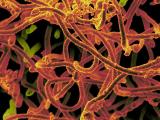Apr 8, 2005 (CIDRAP News) The toll in Angola's epidemic of Marburg hemorrhagic fever has continued to climb sharply, reaching 174 deaths out of 200 cases, according to the latest reports.
WHO officials in Geneva today put the death toll at 174 and warned that it will take a determined effort to stop the disease, several news services reported. "The situation in Angola is not under control yet," Dr. Mike Ryan, director of WHO's alert and response operations, was quoted as saying. "This is still a crisis, and a health crisis at the national level, and requires a profound commitment from national authorities and the international community."
In a statement released late yesterday, the WHO said the outbreak had increased to 200 cases with 173 deaths as of Apr 6, an increase of 19 cases and 17 deaths since the day before.
The outbreak has reached into seven of Angola's 18 provinces, but it has attained epidemic proportions only in northern Uige province, the origin and epicenter of the outbreak, an Agence France-Presse (AFP) report said.
Ryan said international and local health agencies will need to work hard for the next 4 to 6 weeks to stop the epidemic, AFP reported. Another WHO official, Anarfi Asamoa-Baah, told AFP in Angola yesterday that the outbreak is "going to get worse before it gets better."
The WHO recommended yesterday that Angola's four immediate neighborsCongo, the Democratic Republic of the Congo, Namibia, and Zambiago on alert because of the outbreak, the AFP story said.
Yesterday's WHO statement said a portable field laboratory is operating in Uige and a second one should soon be operating in Luanda, the capital, to provide rapid diagnostic tests.
A network of five international labs is providing support "for situations in which exceptionally precise diagnostic results are important because of the implications for control measures," the agency said. Those labs are in the United States (Centers for Disease Control and Prevention in Atlanta); Winnipeg, Man., Canada; Hamburg, Germany; Marburg, Germany; and Sandringham, South Africa.
Scientists from the international labs are sharing test results and information on techniques in a virtual network and during weekly teleconferences, the WHO said.
Epidemiologists have been puzzled as to why about 75% of those infected by the deadly virus, at least until very recently, have been children under age 5. Pierre Formenty, a WHO expert on hemorrhagic fevers, said investigators suspect that the hospital in Uige might have contributed to spreading the virus among children, according to a Reuters report today.
"There is a possibility . . . that the hospital served to infect children who came to be treated there," Formenty was quoted as saying. "It is not confirmed, but it is a hypothesis."
Ryan said it is essential for health workers to gain the trust and cooperation of Angolans so that they will heed warnings not to touch sick people or the bodies of victims, according to the AFP story. He said local people appear to have lost confidence in the medical system, which is weak in the aftermath of 27 years of civil war.
See also:
Apr 7 WHO statement
http://www.who.int/csr/don/2005_04_07/en/




















